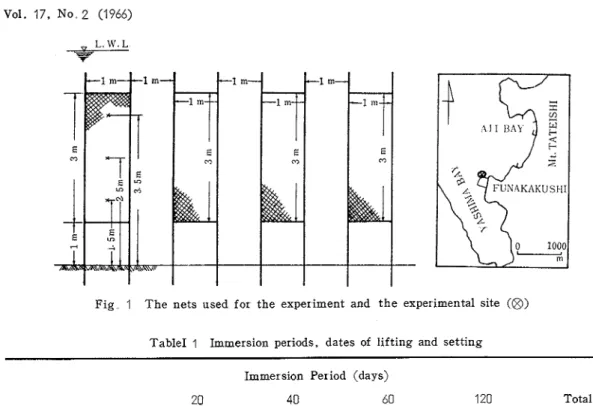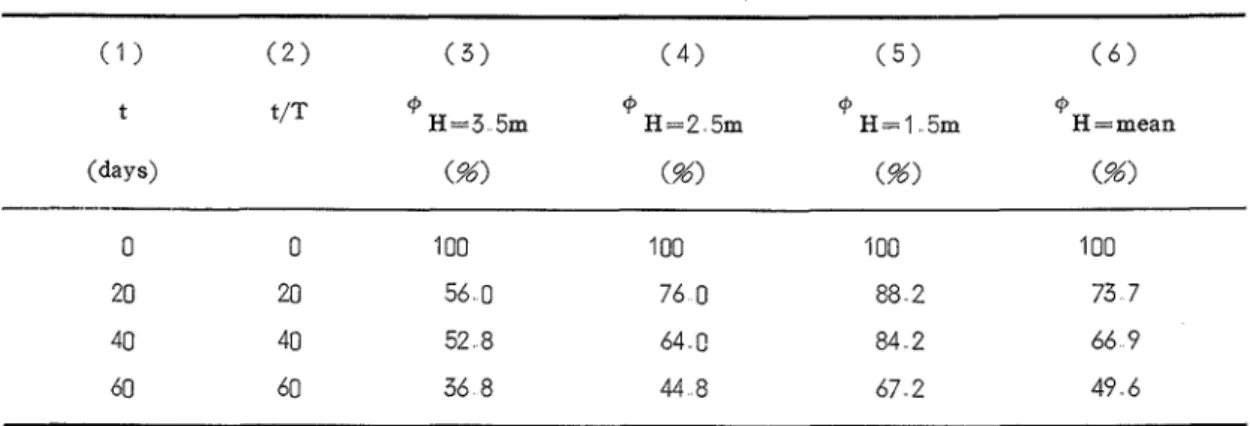Tech Bull. Fac. Agr . Kagawa Univ..
A STUDY ON THE SHALLOW-MARINE
GULTURAL FACILITIES
ON THE FLOW AREA OF IMMERSED NETS
Kiyoshi FUKUDA, T a d a o MAEKAWA, Yoshihiro KONO,
Masaaki ONISHI a n d Hideyuki FUKUMOTO
Introduction
There are 627 pisciculture facilities in Japan and about 80 per cent use synthetic fiber nets"). The handling of the nets- changing- washing -drying -and putting into place- take up a large portion of the manpower at these facilities. Up to now, the nets have been changed every 10 to 45 days depending on the amount of material that catch onto t h e net. Of course, the longer t h e nets stay in the water less handling there is.
This study was conducted to find out how long the nets could stay in the water.
We placed the nets in the water for a 20 day period, a 40 day period and a 60 day period (the 120 day period was destroyed by a typhoon). After each period the nets were photographed in the water and after they were pulled up, but the underwater photographs were unuseable because of the inadequate method used to take the photographs. T h e flow area (the open area of the meshes) were measured from the photographs that were taken on board a small fishing boat.
Material and equipment
We used white, 24 yarn,
8
knot polyethylen fiber net. This was cut into pieces 1 meter by 3 meter and placed on bamboo frames a s shown in Fig. 1. A miniature Nikon F camera was used to take photos of the net on board a fishing boat and of the s l ~ d e s that were projected and enlarged on a semitransparent section paper. A miniature camera Nikonos was used to take underwater photos of the nets, however, these were unuseable because of the inavailability of aqualungs for this experiment. We definitely recommend t h e use of aqualungs to enable the photographer to take close. underwater photos of the net. This would give an adequate picture of the net in actual environment.Procedure
This experiment was conducted from July 17 to November 13, 1964, a 120 d a y period. We wanted to find out how much material caught on the meshes in a 20 day period, 40 day period, 60 day period and 120 day period.
On July 17, 4 nets, I m by 3 m , were placed on 4 bamboo frames and placed i n t h e water as shown in Fig. 1.
6 nets were used for the 20 day immersion period, 3 nets for t h e 40 day immersion period, and 2 nets for the 60 day immersion period (the net placed to measure the flow area of the 120 day immersion period was destroyed by a typhoon) T h e setting and the
vol. 17, No. 2 (1966)
Fig 1 T h e nets used for t h e experiment and t h e experimental site (@)
Table1 1 Immersion periods, dates of lifting and setting
Immersion Period (days)
20 40 60 120 Total No Date S L S L S L S L S L 1 Jul 17 2 Aug 5 3 Aug 25 4 Sept 14 5 Oct 4 6 Oct 24 7 Nov 13 Total
S : Number of experimental nets set into sea water L : Number of experimental nets lifted from sea water
lifting dates of each net are listed on Table
1.
As each net was brought out of the water it was photographed with a minia- ture Nikon F camera with color films (Fuji color R
100)
.
The films were made into slides and the slides were projected and enlarged on a semitransparent section paper,40
c n by30
cm. Photographs were then taken of t h e projected slides from t h e other side of the screen (the semi- transparent section paper).
'Thus, the material that caught onto the threads ofFig 2 A photograph of a 20 day immersion period net
1 22 'Tech Bull Fac Agr Kagawa Univ
the net were photographed against a section paper enabling us to measure t h e flow area (the opened area of the net meshes) and thus enabling us to calculate the amount of obstruction. See Fig. 2.
Results and discussion The calculation was done with the equation
(b = (a/A) x 100
.. ....
"." . ..
"... ...
" . "
..
(1)a represents the average flow area of the encrusted mesh. A represents the original flow area. a/A was multiplied by 100 to get the percentage. (b represnts the ratio between the average encrusted area and t h e original flow area.
The data obtained from this experiment were computed by the above equation and the values of
4
were listed in Table 2.Table 2 Relations between q and t / T
( 1
1
( 2 ( 3 ) ( 4 ) ( 5 ) ( 6 ) t t/T 9 H = 3 5m 9 H = 2 5m @ 9H = l 5m H = mean
(days) (%) (%) (%> (%)
On column (
2)
of this table, we use a dimensionless variable t / T , where T is a one day immersion period.
Using figures from column (2) and ( 3 , (2) and (4)
,
(2) and (5) , we plotted points A, B , C, D , and A , B', C', D' and A , B1', C", Dl' on a coordinate as shown in Fig. 3. The axis of the abscissa is t / T and the axis of the ordinate is the ratio4 .
We observed that these plots did nct lie on a straight line but appeared in a smooth curve. We figured that if additional pairs of values for
9
and t / T were obtained and if they were plotted, three'
three degree curves could be drawn.40
-
D*\Using three three degree equations we obtained
30
-
Qo the additional values for (b and for t / T and got three
20 40
three degree curves as shown in Fig. 3.
'/r
Fig 3 Relationship between g, The three degree equation used to obtain additional and t / T values for column (2) and column (3) was
Vol 17, NO 2 (1966)
where H (m) is the depth of immersion, measured from the bottom of the bay up to the sea level,
and for column (2)and (4) was
and for column (2) and (5) was
From these figures and from the three degree curves on Fig. 3, it would be better to change the nets in the shortest period of time possible, however, if the nets were to be left i n the water for 20 days then it would be just as well to leave them in the water for 40 days since the difference between the two i s only
7
per cent.Another factor that we discovered was that more materials caught onto the meshes near the top (near the sea level) so that a s the value of H (the depth of immersion measured from the bottom of the bay) decreases the value of d, increases. At t/T=20 we obtained the values $=56.0 per cent at H = 3 . 5 m , $=76.0 per cent at H=2.5m, and $=88.2 per cent at H=1.5 m.
Summary
Materials such as marine creatures, sea debris, and etc., catch onto the nets and causes an obstruction in the flow of water through the nets. From this study we found that when nets are kept jn the water for 20 days the flow area decreases to about 74 per cent of the original flow area. A t 40 days the flow area decreases to about 67 per cent and
60
days i t decreases to about 50 per cent.
From this data, i t is best to change the nets as early as possible before 20 days, however, if the nets are kept in the water for 20 days then i t is just as well to leave them in for 40 days since the difference in the flow area between the two is so little. This would save a good deal of manpower for the facility.
We also found that there is a great deal of difference in the flow area between the net near the sea level and the net near the bottom of the bay.
Acknowledgements
The writers wish to thank Mr. Takeo IZUMI the president of Izumi Fishing Co. and his workers for their help to this work, and Mr. Toshiaki NARUHIRO, Mr. Shuji SHIMONO and Mr. Kazuhiro SHIIKI former students of Kagawa University for their help in the obser- vations, and Mrs. Chieko MATSUBARA a member of our laboratory for her assistance of thiz work.
124 Tech。Bull。FacL.Agr。Ⅸagawa Univ. R¢f¢ren(:e
(1)MAEkAWA T.,SAITO M.,FuxuDA K..,AND XoNO Y∴Tec..Bull.Fac… Agr.,Kagawa Univ。. 1る,151(19占5). (Received October50,1965) 浅 海 養 殖 施 設 に 関 す る 研 究 海水に浸した網目の付着物による海水流通面積の減少に.ついてこ 福田 清,前川忠夫,河野義広,大西正明,福本秀幸 要 旨 わが国の浅海養魚施設の約80%(.19る5年調査)は,養魚海面を・締切る材料として舶(多くは化繊網)を 用いている..この細には,海産生物・泥土などが付着して綱目をふさぎ,海水流通面横(流積)を減少さ替る.. これを防ぐため,多くの施設でほ,その付着物の嵐に応じて,1ロー45日ごとに禍を交換している.この仕事は,施 設の労力費にかなりのウエイトを占め,また網の耐用年限にも影響する大き問題とされている. 付着物の付かない網ほ,現在のところ出現していないから,適当な網交換日数を見出すことほ,問題解決の一・方法 と言えよう.これには,まず,流積減少の実態を知る必要があろうn ここにおいて,筆者らは,試験綱(1m(巾)× 5m(高),24本,8節,ポリエチレン)を,香川県庵治湾の海中に垂直に立てて海水中に浸し,海水に浸して−いる時 間の長さと,流積が減少して.ゆく模様を観測した.. 実験は,19占4年7月∼11月の問私行われた.その結果は,海水に浸す時間の長いはど,海面に近い綱目はど流積が 減ずるけれども,海水に浸す前の流積を100%とすると,平均して,海水に浸す時間が20日のときほ約74%,40日の ときほ.約る7%,そしてる0日では約50%に減少することがわかった. このdataによれば,20日以前ならば,なるべく早目に網を交換した方が良い..しかし,20日をすぎれば,40日で交 換しても大差ほないと言えよう. なお,この研究に・は,文部省科学研究費(総合研究)の補助を受けた。ここに記して,当局に謝意を表する。

